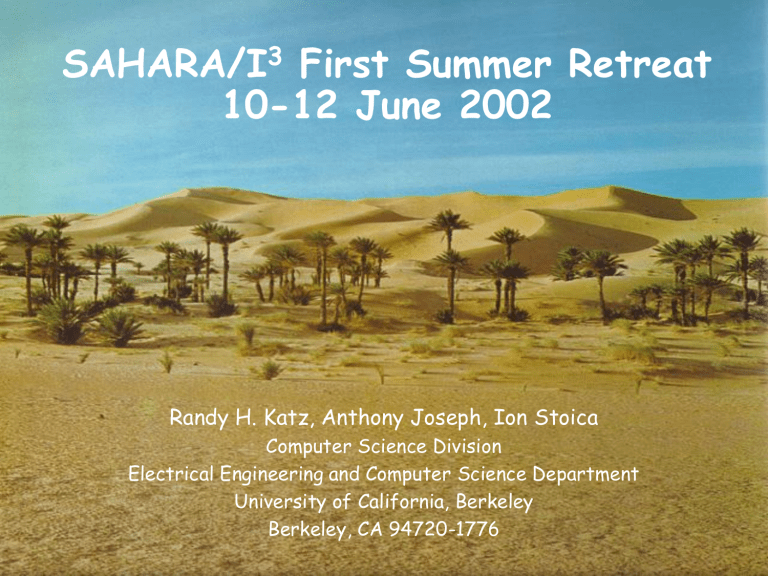ppt - The SAHARA Project - University of California, Berkeley

SAHARA/I
3
First Summer Retreat
10-12 June 2002
Randy H. Katz, Anthony Joseph, Ion Stoica
Computer Science Division
Electrical Engineering and Computer Science Department
University of California, Berkeley
Berkeley, CA 94720-1776
1
Retreat Goals &
Technology Transfer
People
Project Status
Work in Progress
Prototype Technology
UC Berkeley Project Team
Early Access to Technology
Promising Directions
Reality Check
Feedback
Industrial Collaborators
Friends
2
Who is Here (Industry)
• AT&T Research
– Yatin Chawathe
• CMU
– Hui Zhang
• Ericsson Research
– Per Johansson (VIF)
– Martin Korling
• Hewlett-Packard Labs
– John Apostolopoulos
– Wai-Tian Dan Tan
• Intel Research
– Timothy Roscoe
• Keynote Systems
– Chris Overton
• Microsoft Research
– Venkat Padmanabhan
– Lili Qui
– Helen Wang
• Nokia
– Hannu Flinck
• Nortel Networks
– Tal Lavian (PhD student)
• NTTDoCoMo
– Takashi Suzuki (VIF)
– Gang Wu
• Sprint ATL
– Bryan Lyles
– Paul Jardetzky
• UC Davis
– Chen-nee Chuah
– Dipak Ghosal
• Univ. Helsinki
– Kimmo Raatikainen
• Univ. Washington
– Tom Anderson
• Other Affiliation
– Peter Danzig
Italics indicates Ph.D. from Berkeley
VIF=Visiting Industrial Fellow 3
Who is Here (Berkeley)
• Professors
– Anthony Joseph
– Randy Katz
– Ion Stoica
– Doug Tygar
• Postdocs
– Kevin Lai
• Technical & Admin Staff
– Nathan Berneman
– Bob Miller
– Keith Sklower
• Grad Students
– Sharad Agarwal
– Matt Caesar
– Weidong Cui
– Steve Czerwinski
• Grad Students
– Yitao Duan
– Ling Huang
– Almadena Konrad
– Karthik Lakshminarayanan
– Yin Li
– Huang Ling
– Sridhar Machiraju
– George Porter
– Bhaskar Raman
– Anantha Rajagoplala-Rao
– Mukund Seshadri
– Jimmy Shih
– Lakshmi Subramanian
– Ben Zhao
– Shelley Zhuang
4
Retreat Purpose
• Second SAHARA retreat
– Project launched 1 July 2001
– Review progress, set directions, particularly in terms of integrating the diverse efforts underway
• “Generation after next” networks
– Software “agents,” not protocols
– Converged data and telecommunications networks
– Heterogeneous access plus core networks
• Emerging network-aware distributed architecture
– Confederation vs. brokering in service provisioning
– Exploiting network structure-awareness
– Four layer “reference” architecture
• Industrial feedback and directions
– Real-world networking problems/limitations
– Helping us do relevant research at Internet-scale
5
Plan for the Retreat
• Monday, 10 June 2002
– 1200-1315 Lunch
– 1315-1500 Retreat Overview and Introductions (Randy)
» Retreat Overview & Sahara Progress, Randy Katz
» Research on Adaptive Systems, Anthony Joseph
» I3 Overview, Ion Stoica
– 1500-1530 Break
– 1530-1700 Routing as a Cross-Domain Service (Randy)
» Ion Student: Multicast on I3
» Mukund: Interdomain Multicast
» Sharad: Policy Agent for Interdomain Routing
» Lakshmi: Overlay QoS
– 1700-1730 View from a Tier-1 ISP (Chen-nee)
– 1730-1800 Break
– 1800-1915 Dinner (Joint with ROC Retreat)
– 1915-2015 Alfred Spector, IBM (Joint with ROC Retreat)
– 2015-2100 Student Poster Session
6
Plan for the Retreat
• Tuesday, 11 June 2002
– 0730-0830 Breakfast
– 0830-1000 Joint I3/Tapestry Session (Kubi/Ion)
» Services on Infrastructure, Kubi/Ion
» Mobility on I3, Shelley/Kevin
» Mobility on Tapestry, Ben
– 1000-1030 Break
– 1030-1200 Adaptation and Applications (Anthony)
» Modeling/Analysis of Non-Stationary Net Characteristics, Almudena
» Always Best Connected, Machi
» VoIP Gateway Selection, Matt
– 1200-1300 Lunch
– 1300-1600 Long Break
– 1600-1800 SAHARA Architecture and Brainstorming Session (Randy)
» Four Layer Architecture, Bhaskar
» Hot Spot WLAN Testbed for Sahara Integration, Jimmy
– 1800-1915 Dinner (Joint with ROC Retreat)
– 1915-2000 Panel on Robust Manageable Distributed Systems
– 2000-2130 Second Graduate Student Poster Session
7
Plan for the Retreat
• Wednesday, 12 June 2002
– 0730-0830 Breakfast
– 0830-1000 Six Month Planning (Anthony)
– 1000-1030 Break/Room Checkout/Photo Session
– 1030-1200 Industrial Feedback (Randy)
– 1200-1300 Lunch
– 1300-1700 Bus back to Berkeley
8
SAHARA: 2001-2003
• S ervice
• A rchitecture for
• H eterogeneous
• A ccess,
• R esources, and
• A pplications
9
Babblefish
Translator
Scenario: Service
Composition
JAL
UI
Restaurant
Guide Service
NTTDoCoMo
Zagat Guide
Sprint
User
Tokyo
User
Salt Lake
City
10
Sahara Research Themes
• New mechanisms, techniques for end-to-end services w/ desirable, predictable, enforceable properties spanning potentially distrusting service providers
– Architecture for service composition & inter-operation across separate admin domains, supporting peering & brokering, and diverse business, value-exchange, access-control models
– Functional elements
» Service discovery
» Service-level agreements
» Service composition under constraints
» Redirection to a service instance
» Performance measurement infrastructure
» Constraints based on performance, access control, accounting/billing/settlements
» Service modeling and verification
11
Cable
Modem
Connectivity and Processing
Access
Networks
Premisesbased
LAN
Transit Net
LAN
LAN
Premisesbased
Core Networks
Private
Peering
WLAN Transit Net
WLAN
WLAN
NAP
Internet
Datacenter
Analog
Operatorbased
Cell
Cell
Cell
Regional
Public
Peering
Data
H.323
Voice
Transit Net
PSTN
RAS DSLAM
H.323
Data
Voice
Wireline
Regional
12
Service Composition Models
Cooperative
Negotiation & control path
Service Service Service
Data flow
Brokered
Negotiation & control path
Broker
Service
Data flow
Service Service
13
Layered Reference Model for
Service Composition
End-User Applications
Applications Services
Middleware Services
End-to-End Network
With Desirable Properties
Enhanced Paths
Enhanced Links
IP Network
14
Layered Reference Model for Service Composition
Composed Service at Layer i
Measurement-based
Adaptation
Interoperabilty
Dynamic Resource
Allocation
Policy
Management
Trust Management/
Verification
Underlying
Composition
Techniques
Component Services
Services at Layer i-1 at Layer i
15
Mechanisms for Service
Composition
• Measurement-based Adaptation
– Examples
» General-purpose third party end-to-end Internet host distance monitoring and estimation service
» Universal In-box: Application-specific middleware measurement layer to exchange network and server load using link-state algorithm
» Content Distribution Networks: measurement-based
DNS-based server selection to redirect client to closest service instance
16
Mechanisms for Service
Composition
• Utility-based Resource Allocation Mechanisms
– Examples
» Auctions to dynamically allocate resources; applied for spectrum/bandwidth resource assignments to MVNO from underlying competiting MNOs
» Congestion pricing: influence user behavior to better utilize scarce resources; applied in:
• Voice port allocation to user-initiated calls in H.323 gateway/Voice over IP service management
• Wireless LAN bandwidth allocation and management
• H.323 gateway selection, redirection, and load balancing for Voice over IP services
17
Mechanisms for Service
Composition
• Trust Mgmt/Verification of Service & Usage
– Authentication, Authorization, Accounting Services
» Authorization control scheme w/ credential transformations to enable cross-domain service invocation
» Federated admin domains with credential transformation rules based on established peering agreements
» AAA server makes authorization decisions, liberating providers from preparing rules for each affiliated domain
– Service Level Agreement Verification
» Verification and usage monitoring to ensure properties specified in
SLA are being honored
» Border routers monitoring control traffic from different providers to detect malicious route advertisements
18
Mechanisms for Service
Composition
• Policy Management
– Visibility into local policies to better coordinate global policies among (cooperating) service providers
– Developing inter-AS architecture for load balancing, performance and failure mode policies to be applied throughout the network
» Internet topology discovery through AS relationship map of the Internet plus measurement infrastructure
» Policy agent framework for inter-AS negotiation to manage incoming traffic
19
Mechanisms for Service
Composition
• Interoperability through Transformation
– Interoperability of data, protocols, policies among composed service providers
– Example
» Broadcast federation: global multicast service composed from multicast implementations in different provider domains
» Protocol transformation gateways between admin domains employing non-interoperable multicast protocol implementations
20
Summary and Conclusions
• Goal: Evolve (mobile) Internet architecture to better support multi-network/multi-service provider model
– Dynamic environment, location-based implies larger numbers of service providers & service instances
• Status: architectural specification driven by selected applications and underlying wide-area services
• Focus:
– Composition across confederated vs. independent service providers: peer-to-peer vs. brokering
– Explore new techniques/technologies:
» Market-based mechanisms
» Trust management, SLA verification, perf. monitoring
21
Our Mascot
44



